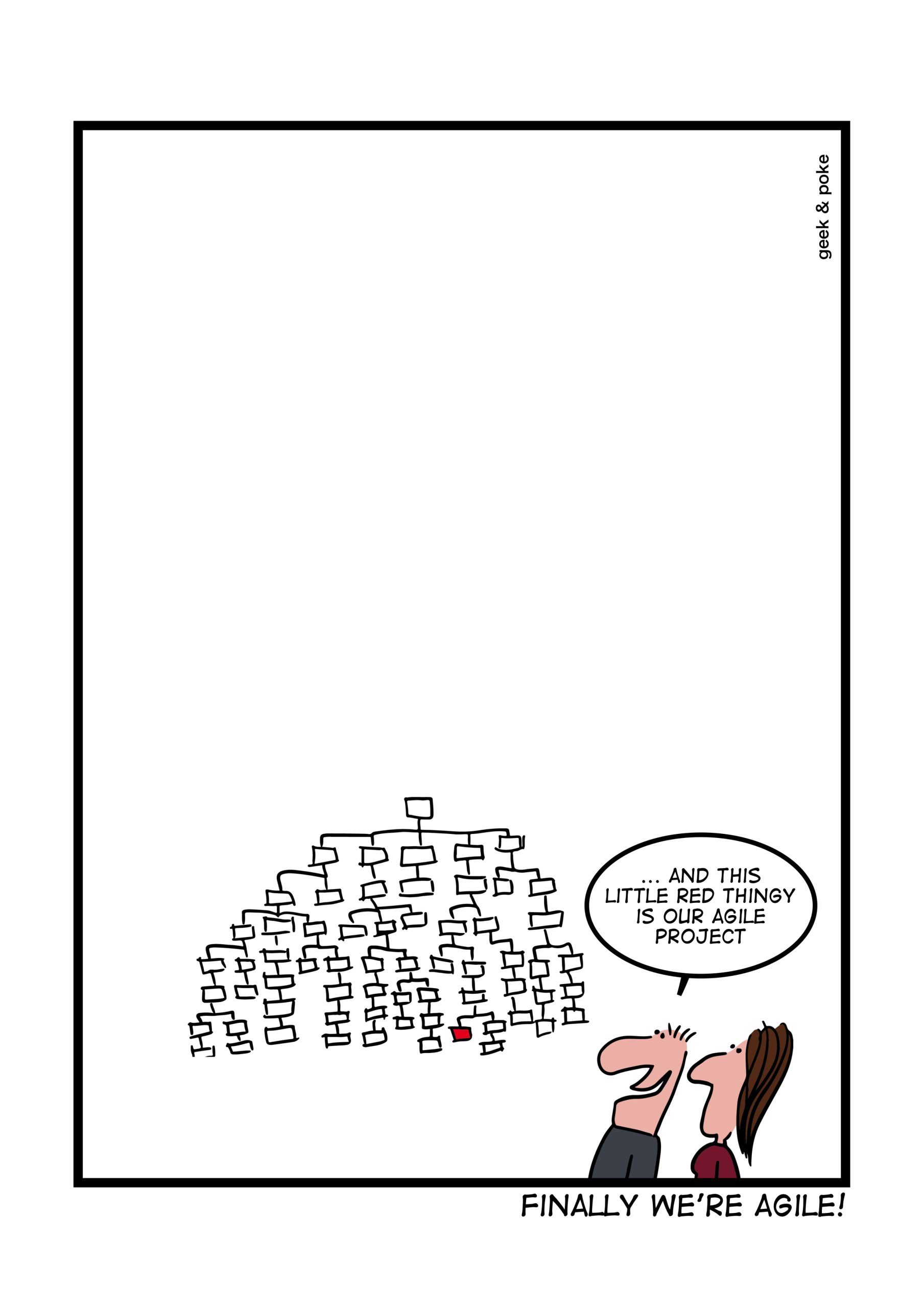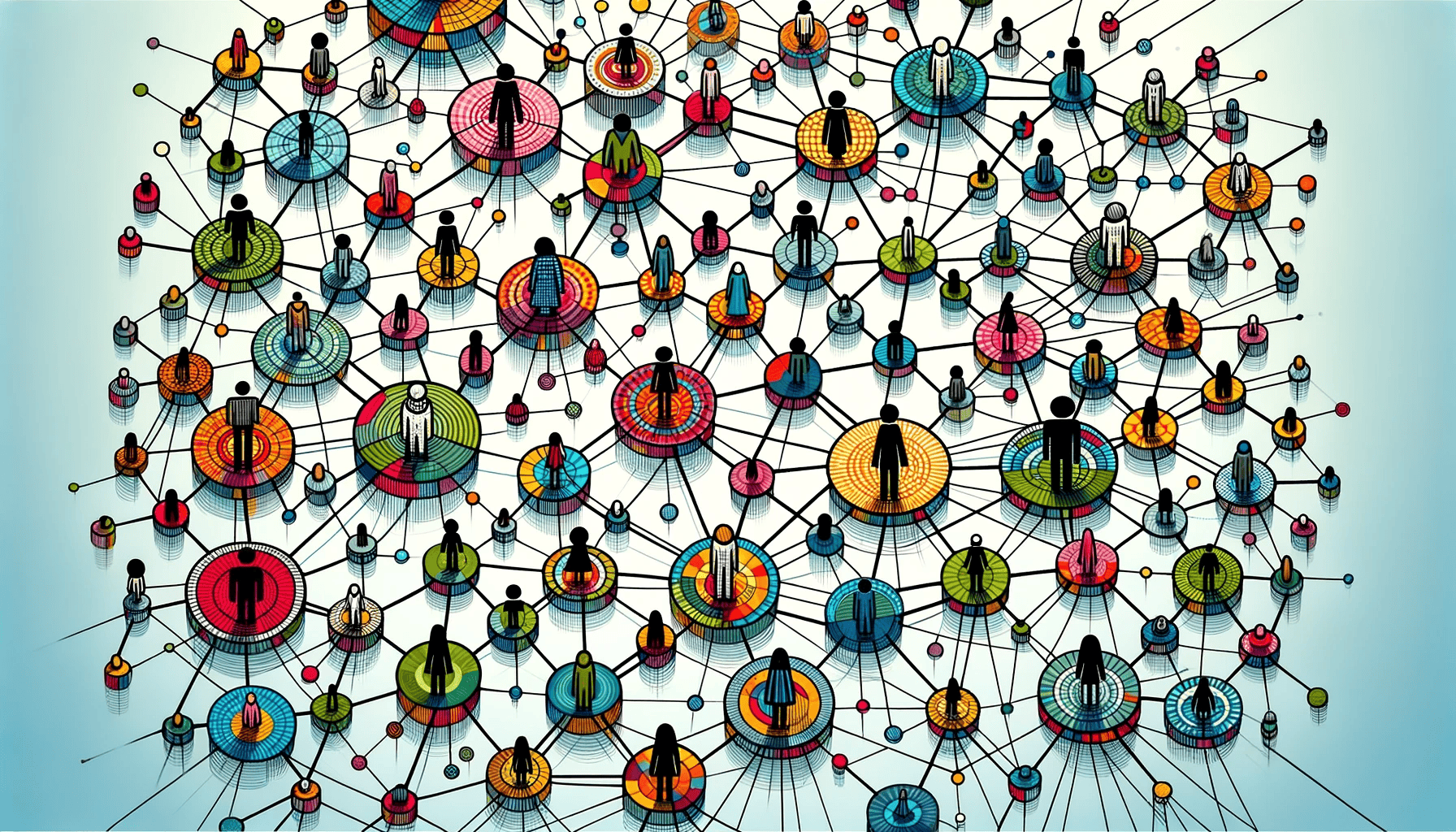Self-organizing companies don’t need managers but coaches
If you are a manager or consider managing teams and organizations a significant part of your profession, the title will likely cause a feeling of rejection or a strong disagreement. I invite you to read on anyway.
If you are an agile coach, your impulse might be to use this article to justify your position or highlight the importance of agile coaching. And while agile coaching can have value, I am not talking about classic agile coaching as we often see it in traditional hierarchical organizations. This is a part of it, but self-organizing companies need coaching beyond that.
Nonetheless, both groups, managers and agile coaches, might possess the intrinsic motivation and many of the skills needed to move into a coaching role in a self-organizing organization. Self-organization opens huge opportunities for people who have had one of these roles. The opportunity to have more impact, enjoy work more, and work through genuine human connection.
But why should you care?
Before we dive into this topic, I want to clarify: My stance is not against the person who does management in traditional organizations. It is about the manager role/title. People who go into management often do so because they want to have an impact and change things for the better that they couldn’t influence without that position. I admire that drive and dedication. In traditional organizations, people often have no other way than to become managers to improve the organization.
Why Self-Organization is Desirable
The benefits of self-organization over traditional organization structures can fill multiple articles independently (getting there …). Nonetheless, I want to briefly make the case for self-organization and explain why this should be of the highest interest to anybody caring for their organization.
1. It makes companies adaptable
It is impossible to build the perfect organizational structure in a complex world. Whatever we create needs to adapt over time. Traditional hierarchies complicate this.
First, they disconnect people at the bottom from the ability to impact the organizational structure that is supposed to support them in doing the best possible work.
Second, traditional hierarchies create intrinsic interest in people in leading positions to preserve the structure.
This together reduces organizational adaptability. In self-organizing companies, people in all roles have the ability and interest to raise and process tensions with the current organizational structure and drive the change needed to work better.
2. It makes companies more resilient
Self-organizing companies have more leadership. Not less. Everybody can lead to the extent they feel capable and comfortable. The empowerment to lead is built into the system. This also means greater autonomy and responsibility.
In those organizations, there are many people one can turn to when discussing tensions. Whoever I trust or whoever might have the most insights into the matter can help me.
Compare this to traditional hierarchies, where the manager is a single point of failure. The manager winning the lottery and quitting is significant for the organization and the people reporting to this manager. – This is the opposite of organizational resilience.
3. Self-organization is more natural
Traditional management assumes that organizations are like machines we can design, construct, and create. This is a simplified but flawed model.
Organizations are living systems consisting of other living systems (teams and people), making them messy. Treating them with a simplified model doesn’t get any less messy.
Defining rigid structures and boxes and forcing people to fit into them removes the humaneness from the workplace. This made sense in a Tayloristic world, where people were seen as replaceable gears in a machine.
It doesn’t make sense today when everything is changing quickly, and everything has become more complex. To be successful, we need people to be engaged, motivated, and thinking in all positions and roles. Traditional hierarchies make this less likely.
4. Self-organization is healthier
Self-organization enables people to shape their work environment to support them in their work best. It gives them ownership. It connects them with the organizational purpose and gives their work meaning and importance.
It also allows for deeper and more authentic human connections in the workplace, as it removes managerial power imbalances and unites everyone toward a shared purpose. This can get people more excited about their work, more motivated and engaged, and thus reduce the risk of burnout. This not only makes people healthier but also more creative and more productive.
5. Community over competition
Traditional hierarchies create a conflict of interest between achieving organizational goals and climbing the hierarchy.
Leaving all the management fluff away, people come together in organizations to achieve a common and desirable goal together. Now add managerial hierarchies, career leaders, titles, and positions, and if you are lucky, people think about that goal during quarterly OKR planning, if at all.
This doesn’t happen so much in self-organizing companies because there is no hierarchy to climb, or at least it is less desirable. There is no higher status or money to gain just because you outperform your peers. Outperforming your peers isn’t desirable. Self-organization isn’t about competition but collaboration. Together, we can achieve more. As people are inherently powerful in a self-organizing system, they can influence the things they want to influence without needing to climb a career ladder. They can contribute efficiently to improving the system in the area where they have the most stakes, the most interest, and the most expertise. They will happily follow others on other topics.
6. Agile works, iff …
Agile works. – That is, if you don’t limit it to the boundaries of a team and if people can change the organization as they discover a tension with current structures and processes. Putting it differently: Traditional hierarchical companies are unlikely to reap the benefits of agile work. Even worse, “agile” in those companies is often nothing more than a buzzword or a farce, as the changes needed for true agility cannot happen without convincing layers of management.

“Finally Agile” (https://geek-and-poke.com/geekandpoke/2016/4/26/finally-agile)
I could continue …
This list is far from complete, and I am, in fact, already collecting material for another article on the benefits alone, in which I also plan to dive deeper into the reasons I mentioned before (and several more).
Why Traditional Organizations Have Managers
In traditional hierarchical organizations, managers seem to have a crucial function for the org to work. But what is that? And why and how can this function be provided differently and better in self-organizing companies?
1. Managers are links between teams
They represent the team, and they route essential information. They reduce the communication overhead and cognitive load for the team.
This implies, that the manager knows exactly what information their reports consider important and how the team needs to be represented. As managers usually do not sit with the team all day, this implies more meetings for the team to communicate their needs and information to the manager. The manager is a proxy and a single point of failure.
This function can better be fulfilled by leadership tags that people on the team hold. The team decides who holds which tag. There can be a tag for technical leadership and one for product leadership or whatever kind of leadership the organization needs. The needs and the tags can change over time. And it is completely fine to change the tag holder. This is a team decision, almost like a democratic election.
Furthermore, the focus should be on reducing team dependencies, not to manage them.
2. Managers ensure that everything that needs to get done gets done
Having a dedicated person with that responsibility makes sense if the team only consists of disengaged people just in for the paycheck. Somebody whose dedicated responsibility is to own the outcome. Somebody who is paid and placed into their position for precisely this job by upper management.
The narrative is that traditional hierarchies exist because of disengaged, irresponsible, or lazy people. The opposite is closer to the truth: Disengaged, irresponsible, and lazy people exist because of traditional hierarchies.
In self-organizing teams, everybody feels responsible for outstanding outcomes. The teams will develop such high standards that no manager must ensure up-living to them. Again, leadership tags can further support this.
3. Managers are responsible for building teams
“Engineers are responsible for building quality software; managers are responsible for building quality teams.“
I lost count of how many times I heard this or similar statements. They sound logical but are fundamentally flawed.
Software is a lifeless thing that can be manufactured, modified, or shaped. Like a sculptor uses a hammer and a chisel to change the sculpture, engineers use IDEs and commits to change software.
When we see organizations as machines, this applies to organizations as well. However, this does not make sense if we see organizations as living systems.
Teams cannot and should not be changed from the outside. People should not be forcefully changed. You can’t change people. This is bound to create resistance and suboptimal results. People and teams can evolve as they discover other ways of being that better support their purpose. The team’s responsibility, especially tag holders, is to provide everything needed for this evolution.
4. Managers exist to communicate the purpose
In traditional companies, managers create teams and assign their purpose. In self-organizing companies, teams form naturally or when people notice an important function isn’t handled. Here, the team’s purpose is either already clear or is discovered by the team itself.
A purpose discovered has way more impact than a purpose told.
5. Managers provide feedback
“Whose responsibility is it if somebody does not perform well? Who has those difficult conversations? Who provides feedback, and who does performance reviews?” – Clearly, the manager!?
Giving feedback can be difficult and uncomfortable. Therefore, we have managers trained in and used to give feedback. Problem solved!? No!
Relying on managers to give feedback is problematic. First, they often are only a proxy for feedback by somebody else who feels uncomfortable giving it. They, therefore, lengthen the feedback loop and might even alter the message or put it out of context. Furthermore, proxying feedback removes the opportunity to connect and strengthen relationships.
Feedback should be given directly by anyone, including peers with concerns or appreciation about our communication or work. Coaches can help process frustrations and make feedback empathetic and easily understood.
In self-organization, giving and receiving feedback is easier. With closer relationships and trust among peers and a shared purpose without selfish motives, feedback is seen as supportive help to contribute better to the common goal. It’s seen as valuable, not something that might affect promotions.
The worst form of feedback is a performance review. Delayed and indirect feedback that could have been valuable months ago. (Again, that will be another article on its own.)
Giving helpful and difficult feedback is crucial for humans, not only in the workplace. Therefore, training people to give better feedback has a positive impact beyond the workplace. Relieving people from the need to give feedback by leaving this job to a single person introduces a single point of failure (again) and does a huge disservice to humanity.
6. Most organizations have managers. This is the default.
It never was a good reason to do something because most others do it. Traditional hierarchies date back to Taylorism and the belief that workers need to be controlled and managed to do their work well.
Taylor’s view of the world created a very distinctive and dehumanizing workplace culture. … The software industry we joined in the nineties had transplanted Taylor from the factory into the cubicle. – Agile Conversations
This might have been true when work was shaped to be meaningless and dull, and the work itself was simple and repetitive. Software work isn’t simple and repetitive, and it should not be meaningless and dull (unless shaped to be so (by managers))
“Managers are the default.” = “We always did it like this.”
That should alert us even more to whether this is the best way to run organizations and if the premises under which management was once introduced still hold today.
Why Self-Organizing Companies Need Coaches
The argument that the default is having managers has some truth in it. The implication is that most people are not used to working in self-organizing companies. They have some expectations and beliefs in how companies work that do not fit.
It can be a culture shock when coming into a self-organizing workplace.
- Suddenly, there isn’t somebody who solves my problems for me.
- Suddenly, I need to build relationships with my peers and give them feedback (and receive feedback); suddenly, I have to own my tensions and process them.
- Suddenly, I cannot do a job as defined by a clear job description but can find ways beyond that to serve the organizational purpose better.
- Suddenly, I can’t just complain about structures or processes hindering my team and me, but I have the permission (and am even expected) to drive the change I want to see.
That is scary. And it can be highly overwhelming, too. Before somebody prioritized things for me, suddenly, I needed to decide which of my tensions I wanted to address first.
Coaches can be very helpful in supporting people. They help organize thoughts, challenge beliefs, and listen. They assist in understanding frustrations and finding solutions. Coaches also aid in recognizing personal needs and desires and guide how to fulfill them within the company and beyond.
The coach’s only motivation is to help the coachee. They need to understand how the organization works and how self-organization differs. This is where coaching in self-organizing companies goes beyond classical agile coaching as practiced in traditional companies.
Coaches must be available, well-connected in the organization, and chosen by the coachee to be most effective. Trust and transparency are the prerequisites for successful coaching.
Why managers are bad coaches
I expect this to create resistance again. A manager’s job is to coach their reports. Now, they should be bad coaches?
Don’t get me wrong. The person who is a manager for one person can be an exceptional coach for another person. They cannot be both for the same person. Or at least not in the best possible way.
The power imbalance inherent in the manager-report-relationship is in stark conflict with the desired levels of trust and transparency in the coach-coachee-relationship.
Even if employees like and trust their manager, they might still hesitate to share their struggles or failures with them. This is because the manager has power over their promotions, hiring, and firing and is not just a coach but also a superior who can influence their future.
This makes coaching by managers less effective. Furthermore, coachees should be able to choose their coaches to ensure a trustful relationship on eye level. Reports usually don’t choose their managers.
Huge opportunity for managers
If you are a manager who enjoys coaching and being a servant leader, you have a massive opportunity in self-organizing companies. You can do more of that in a better, more human, and more authentic way.
If you are good at seeing tensions and driving change to improve systems, there is also a huge opportunity for you: You can have more impact through leadership than through management. You can drive change beyond any managerial boundaries in the organization by inspiring people and awakening their desire to see that change happening.
If you’re a manager who wants to work directly with code again, self-organization could be the solution. In self-organizing systems, people aren’t limited to roles like “manager” or “engineer.” Instead, they use their skills and passions to meet the organization’s goals. This means you could coach some team members, work on coding with others, and identify and address any issues in the system, just like everyone else.
Managers, especially at higher levels, often feel lonely because they think they can’t share their struggles with others. They are expected to have everything under control, but this isn’t always true. Sharing difficulties is hard when you’re in a high position, and others might see your struggles as a chance to replace you. These issues are less likely in self-organizing, purpose-driven systems, where everyone works together towards a common goal. Former managers in such systems may feel more included and less pressured.
“It is lonely at the top.”
I hate this quote. It might be accurate. But then, why do we design systems like this?
“No Managers,” not “No Hierarchies”
Note that there is a difference between having no managers and having no hierarchies. When self-organizing systems grow, they will split into subsystems that will split into even more subsystems. Therefore, there is a hierarchy of systems.
Compared to traditional hierarchies, the crucial difference is that this is an organizational hierarchy of systems, not a hierarchy of people. No one system has more power than other systems; no one can bypass organizational processes for their own interests. No person can prevent changing the organizational structure (and thus the hierarchies) if they can’t come up with a valid objection in the sense and interest of the organization.
Hierarchies in self-organizing companies are not the traditional org-chart hierarchies. They might look vastly different depending on the topic and context. And they are not imposed top-down but democratically chosen bottom-up.
Even in self-organizing companies, work ideally gets done in value-stream-aligned teams. Like good architecture, high cohesion, and low coupling are desirable for teams. This means work can get done without sitting in meetings with other teams all day. This is a forcing function for evolving team structures to better support work across departments or managerial boundaries.
Conclusion
Organizations have been running in the wrong direction for decades, following the wrong objectives. This led to a disconnect between business reality and human nature — the result: Disengaged, frustrated, burned-out, and depressed people. It does not have to be like this. If we treat people like humans, give them a desirable cause to work for, give trust, and listen to their needs and desires, they will outperform any workforce put under hierarchical management.
I believe future organizations will not have managers and rely on coaches to support people to find their way of contributing to the organizational purpose. This is a beautiful opportunity for most managers and everybody involved.
I would love to hear your thoughts on this topic. Bring me all your objections and disagreements. Areas where you see management as crucial and stories from self-organization where it worked well without traditional managers.





Use the share button below if you liked it.
It makes me smile, when I see it.